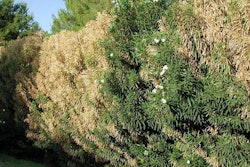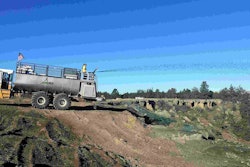 Photo: Houzz
Photo: HouzzHouzz released its fourth annual Landscaping Trends Report and the 2017 findings show that homeowners are interested in creating unique front yard spaces that also boost the house’s curb appeal.
The survey questioned 1,000 U.S. homeowners who are in the midst of, are planning, or have recently completed an outdoor project.
While 69 percent of the outdoor projects took place in the backyard, another 44 percent focused on making their front yards their own. Only 6 percent said that their yards were nearly identical to their neighbors’ lawns post-renovation. Before the project 36 percent said that their yards looked the same as those around them.
As for why the homeowners prefer to have their front lawns look moderately to extremely different from other residents’ the motivation was not polled, but Houzz’s principal economist, Nino Sitchinava, has her speculations.
“Homeowners do take pride in their homes,” she said. “They want them to stand out and make a statement, outdoor spaces make a statement and it’s clearly important to them to make sure their outdoor space reflects their personal style.”
For homeowners who were updating their front yard, 47 percent said that beds or borders were the most important updates for curb appeal, followed by shrubs at 29 percent and perennials at 28 percent.
The new number one motivation for starting a landscaping project is reported to be the purchase of a new home and the desire to make it one’s own at 33 percent. Having outdoor elements deteriorate or break is a close second at 32 percent, since many homeowners (42 percent) reported their last outdoor upgrade occurred more than 10 years ago.
 Photo: Houzz
Photo: HouzzTwo-thirds of homeowners use their outdoor spaces for relaxing, with 56 percent using it for gardening and 40 percent opting for entertaining. During the warm season, respondents said they spend an average of 6.9 hours a week in their outdoor space compared to 2.4 during the cold season.
Of the outdoor living elements homeowners said they would add 36 percent said outdoor lounge furniture and 32 percent said a fire pit. One out of 10 homeowners responded that they were investing in outdoor kitchen equipment.
Nearly half of the residents polled (45 percent) said that they were updating their landscape lighting using everything from path lights to poolside lights. The most popular updated lighting type was LED with 73 percent choosing it and the other options included low-voltage (46 percent), solar (41 percent), ‘smart’ (19 percent) and wireless (16 percent).
According to Sitchinava, the increase in landscape lighting has been a trend they’ve seen over the past three years.
“Lighting is coming into the retail space at more affordable price points, there’s a ton more variety, and it’s an aesthetic feature homeowners are more aware of,” she said. “As there is more emphasis on outdoor living, you have to have lighting to extend the daytime hours where you can enjoy your outdoor space.”
Another portion of the survey revealed that while 63 percent of homeowners plan on hiring a pro for an upcoming project and 55 percent will pay over $15,000 for a complete overhaul only one in five respondents plan to hire help to maintain their newly renovated spaces.
Because only 19 percent are willing to pay a professional to take care of their plants, 76 percent are opting for low-maintenance varieties. Pollinator-friendly and native plants are also continuing to rise in their popularity but edibles have taken a downward trend. In 2015, 41 percent were interested in planting edibles and now it is down to 34 percent.
“I think the decrease is real,” Sitchinava said. “We did go into a bit of a fad with the farm-to-table. There’s another added element to it as well. Historically, the last five to ten years was carried through by baby boomers. They had more time on their hands to garden. The last two years there’s been an uptick in millennials buying homes and they’re more focused on growing a family and a career and have less time for gardening. Edibles are going to be put on a back burner for them, but I still think it will be big for the baby boomers.”
Another interesting statistic that was found by the poll was that while homeowners making changes to their back and side lawns planned to replant or expand it, front yards that were being renovated were more likely to be removed or replaced entirely.
Around 44 percent of those who chose to remove their front yard cited “helping the environment” as their reasoning.
“That is a really interesting trend,” Sitchinava said. “It’s not surprising if you think of the lawn and what function it serves, especially for families with children, it’s more of a friendly surface and in the backyard it’s more functional than the front yard, so as environmental concerns come to mind the first element that is going to give are those which are less functional. They are still holding onto their backyards, but as time and drought considerations increase there is a possibility for lawn removal to increase in the backyard.”
Most front yards that were reduced or removed were replaced with ground cover plants and mulch while synthetic lawns dipped from eight percent in 2015 to 5 percent in 2017.
To check out the full landscaping trends report, click here.










